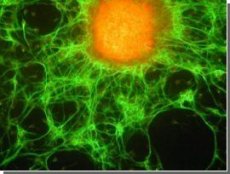Scientists announced the discovery of cancer stem cells
Last reviewed: 23.04.2024

All iLive content is medically reviewed or fact checked to ensure as much factual accuracy as possible.
We have strict sourcing guidelines and only link to reputable media sites, academic research institutions and, whenever possible, medically peer reviewed studies. Note that the numbers in parentheses ([1], [2], etc.) are clickable links to these studies.
If you feel that any of our content is inaccurate, out-of-date, or otherwise questionable, please select it and press Ctrl + Enter.

Three independent groups of scientists simultaneously reported the discovery of so-called cancer stem cells - small groups of cells on which the growth of cancerous tumors depends. Isolation of such cells changes not only the idea of the mechanism of development of malignant neoplasms, but also the approach to their treatment. Two papers devoted to this topic were published on August 1 in the journal Nature and one more in the journal Science.
Thus, the hypothesis has been confirmed that the ability of cancer tumors to resume their growth after long-term remission lies in the existence of a small group of cells that can "wait" for the action of both chemotherapy and radiotherapy in a dormant state to begin active division and start such the same process in other types of cancer cells, initiating the re-development of the disease.
The first assumptions about the existence of such a catalyst and, correspondingly, the hierarchical nature of the growth of cancer cells appeared in the 1990s during a study of the development of leukemia in mice, but they have not yet been confirmed by the example of malignant tumors developing in various tissues of the body.
All groups of researchers who reported their discovery, in order to track the processes occurring in tumors and how they involved different types of cells, used genetic marking methods. In this case, the objects of study for each of the groups had their own.
For example, a team led by biologist Luis Parada of the Southwestern Medical Center at the University of Texas, whose work was published in Nature, focused on glioblastoma, a type of cancer tumor they hypothesized that genetic markers inherent in healthy adult neural stem cells may be similar to glioblastoma stem cell markers. Based on this assumption, the authors did indeed detect tumors of several cells with both by their markers, while the rest of the tumor cells did not contain them.
Further studies have shown that under the action of standard chemotherapy all cells, except for labeled cells, die, after which the tumor growth resumes, with the labeled cells generating all the rest. When the authors managed to suppress the process of division of labeled cells, the tumor actually broke up into fragments that did not become the basis for the development of new glioblastomas.
The group, led by Cédric Blanpain of the Belgian Free University of Brussels (ULB), whose work was also published in Nature, dealt with skin cancer, with all tumor cells being studied. They managed to find out that cancer cells differ in the fission scenario - some of them can be divided a limited number of times, and some, and this is exactly the same stem cells - is infinite. It turned out that in the case when the cancer becomes aggressive, in the tumor are formed for the most part are capable of unrestricted division of stem cells, and not cells of another type. According to Blanpeng, this discovery can be the key to a new cancer treatment strategy in the early stages - instead of removing stem cells, turning them into a different type of cell with a limited ability to divide by therapeutic means.
And finally, a third group of researchers, led by Hans Clevers of the Hubrecht Institute in Utrecht, the Netherlands, whose work was published in Science, focused on cells that form intestinal adenomas, intestinal cancer precursors. Previously, they displayed a line of mice, which the authors called "mouse-confetti" - the rodents carried a genetic marker that, under the influence of a certain substance, caused the cells of the intestine to produce molecules of four colors, depending on which cells they originated from. Scientists managed to get tumors, colored in one color, but consisting of different types of cells, which shows that they all originated from one source - the stem cell. Changing the color of these cells resulted in the appearance of many cells of a similar color, which confirmed the version that stem cells produce all the rest.
As Parada noted, it is too early to say that the new data obtained are applicable to all types of cancer. But if in the course of further research it turns out that this is so, the ways of fighting cancer will change dramatically. In particular, the assessment of the effectiveness of chemotherapy will change - doctors will be guided not by the cessation of growth or even the complete disappearance of the tumor, but whether the cancer stem cells died as a result of treatment.
 [1]
[1]
